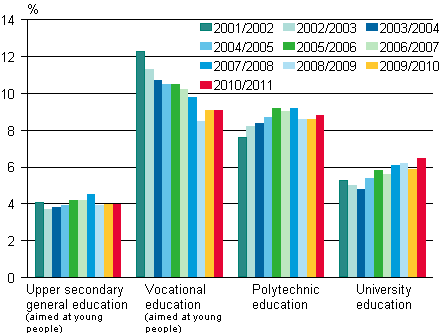Published: 20 March 2013
Discontinuation of education increased in tertiary level education
In all, 5.7 per cent of students attending education leading to a qualification or degree discontinued their studies and did not resume them in any education leading to a qualification or degree during the 2010/2011 academic year. In upper secondary general education, the discontinuation percentage was 4.0, in vocational education aimed at young people it was 9.1, in polytechnic education, 8.8 and in university education, 6.5 per cent. In upper secondary general education and in vocational education, discontinuation remained unchanged compared to the previous academic year but in polytechnic and university education, discontinuation increased. These data derive from Statistics Finland’s Education Statistics.
Discontinuation of education in upper secondary general, vocational, polytechnic and university education in academic years from 2001/2002 to 2010/2011, %

If students who have changed their sector of education, e.g. students who have switched from upper secondary general school to vocational education, are not calculated as discontinued students, the percentages of discontinuation are lower. Most often, the sector of education was changed in upper secondary general education and in polytechnic education.
Of students 18 or older that discontinued upper secondary general school education, 46 per cent continued studies leading to a qualification or degree in some other sector of education, and 19 per cent transferred to work. The respective figures in vocational education were 9 and 33 per cent. Of students that discontinued polytechnic education, 25 per cent continued studies in some other sector of education and 54 per cent transferred to work. Of students that discontinued university education, 15 per cent transferred to some other sector of education leading to a qualification or degree, and 60 per cent started working. The employment data are based on the preliminary data of Statistics Finland's employment statistics from the end of 2011.
Men discontinued there studies more often than women in upper secondary general education, polytechnic education and university education. By contrast, women discontinued there studies more often than men in vocational education. Education was discontinued most often in the field of natural sciences, in the field of natural resources and the environment, and in the field of tourism, catering and domestic services. The relative share of discontinuation was lowest in the fields of other education, which includes e.g. police training, and in the field of social services, health and sports.
Discontinuation of education leading to a qualification or degree by sex and sector of education in academic year 2010/2011 1)
| Sex / sector of education | Number of students used in the statistics on discontinuation of education 20.9.2010 | Discontinued in own sector of education | Changed sector of education | Discontinued completely education leading to a qualification or degree | |
| % | % | % | |||
| Total | 489 729 | 7,3 | 1,6 | 5,7 | |
| Men and women | Upper secondary general education (aimed at young people) | 100 551 | 4,0 | 2,3 | 1,7 |
| Vocational education (aimed at young people) | 130 488 | 9,1 | 0,9 | 8,1 | |
| Polytechnic education (Bachelor's degrees) | 130 762 | 8,8 | 2,2 | 6,6 | |
| University education (Bachelor's and Master's degrees) | 127 928 | 6,5 | 1,0 | 5,5 | |
| Men | Total | 233 168 | 7,9 | 1,5 | 6,4 |
| Upper secondary general education (aimed at young people) | 43 316 | 4,2 | 2,3 | 1,9 | |
| Vocational education (aimed at young people) | 69 277 | 8,6 | 0,6 | 8,0 | |
| Polytechnic education (Bachelor's degrees) | 60 481 | 10,3 | 2,2 | 8,1 | |
| University education (Bachelor's and Master's degrees) | 60 094 | 7,3 | 1,1 | 6,3 | |
| Women | Total | 256 561 | 6,7 | 1,6 | 5,1 |
| Upper secondary general education (aimed at young people) | 57 235 | 3,9 | 2,3 | 1,6 | |
| Vocational education (aimed at young people) | 61 211 | 9,5 | 1,3 | 8,3 | |
| Polytechnic education (Bachelor's degrees) | 70 281 | 7,5 | 2,1 | 5,3 | |
| University education (Bachelor's and Master's degrees) | 67 834 | 5,7 | 0,9 | 4,8 | |
More information related to the progress of studies is available from statistics describing Progress of studies and Employment of students
A total of 298 students had discontinued their studies in comprehensive school during the 2011/2012 academic year. The number of those who had completely dropped out from compulsory education in the spring term was 86 and those over the age of compulsory education having left school without a leaving certificate from comprehensive school was 212. More than half of school drop-outs were boys. The number of boys among those who had completely dropped out from compulsory education was 45, and 117 among those having left comprehensive school without a leaving certificate.
Source: Education. Statistics Finland
Inquiries: Riikka Rautanen 09 1734 2375, koulutustilastot@stat.fi
Director in charge: Riitta Harala
Publication in pdf-format (236.3 kB)
- Tables
-
Tables in databases
Pick the data you need into tables, view the data as graphs, or download the data for your use.
Appendix tables
Updated 20.3.2013
Official Statistics of Finland (OSF):
Discontinuation of education [e-publication].
ISSN=1798-9302. 2011. Helsinki: Statistics Finland [referred: 26.4.2024].
Access method: http://www.stat.fi/til/kkesk/2011/kkesk_2011_2013-03-20_tie_001_en.html

